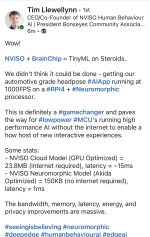Hi
@hotty4040
Historically if we start with IBM's True North they never intended on taking it to the edge it was about trying to develop AGI in the form of a super computer much the same as the idea being pursued with SpinNaker in Europe. So while it is listed as a competitor Brainchip sensibly positioned itself in a space where they would not be confronting IBM's mite in the market place. IBM has always had a relationship in consequence with Universities and engages in cross over research as a matter of course.
Now moving on to Intel and Loihi. As initially disclosed years ago now it ran up against two things with Brainchip the first being that Peter van der Made jumped on a plane and took an exclusive licence to the JAST learning rules before Intel and as a result when Intel's patent came up against Brainchip's patent they were forced to go around.
The problem with this is as I have said many times is the shortest distance between two points (pure mathematicians need not argue the contrary position for the purpose of this analogy ie I do know the Earth is curved) is a straight line and Peter van der Made had made the straight line Brainchip's all the way to convolutional spiking neuromorphic computing.
Intel's solution to the straight line was to endow any university in the world prepared to undertake research using Loihi in an attempt to create a second straight line and to date has not done so and in fact so convoluted is the line that Loihi takes Intel in fact has endowed universities to set up courses that train student engineers and computer scientists in the language of Loihi.
While Intel was trying to create the new straight line to neuromorphic computing using SNN Peter van der Made and Brainchip remained in deep stealth mode and had very limited interaction with the university research community for the purpose of maintaining strict control over its intellectual property.
It was for these reasons that Intel and IBM are cited in many research papers and Brainchip and AKIDA have been ignored. Brainchip was pursuing a course that did not need outside researchers and the risk of intellectual property being stolen.
This year however as you know Brainchip came out of stealth and declared itself fully commercial and in the same breath opened up AKIDA to researchers in universities around the world confident that it had patent protected the straight line that Peter van der Made and Anil Mankar had reserved all the way to artificial general intelligence.
In consequence by the process of AKIDA saturating the market and becoming the default standard, universities will obviously embrace AKIDA technology if for no other reason than as the default standard this is going to be where all the jobs are and students will want to study courses that lead to jobs not further research except in the minority of cases.
Intel over all will probably move to AKIDA as it has a whole new approach to what its primary direction should be and it involves foundries and the people now at the top of Intel were not there when the Loihi project was commenced and have no professional or intellectual stake in it being a success.
The beauty of Brainchip's AKIDA is that you do not need to have studied a specific course to use it thanks to the Meta TF software solution from Brainchip so the fact that they have not been in universities is no impediment to its adoption.
As universities now start to experiment with it they will act as advertisements for AKIDA technologies amazing advantages but they will lag well behind the commercial adopters the names of which you already well know. And yes AKIDA could well displace Intel in this area of university research.
My opinion only DYOR
FF
AKIDA BALLISTA




